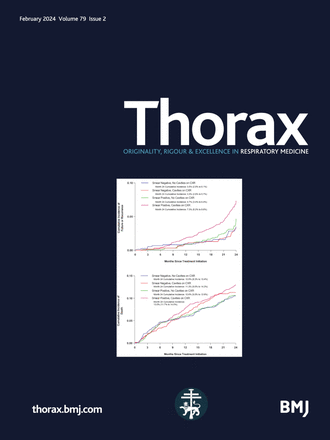神经肌肉和限制性胸部疾病患者的家庭和门诊与住院无创通气:网络荟萃分析
IF 7.7
1区 医学
Q1 RESPIRATORY SYSTEM
引用次数: 0
摘要
长期无创通气(NIV)在门诊或家庭启动的趋势越来越多,而不是在医院启动。然而,在神经肌肉疾病(nmd)或限制性胸廓疾病(rtd)患者中,支持该策略非劣效性的证据有限。方法采用系统评价和网络荟萃分析(NMA)比较三种NIV起始环境(家庭、门诊和医院)对NMD或RTD患者长期NIV疗效的影响。我们使用MEDLINE、Web of Science和CENTRAL (Cochrane CENTRAL Register of Controlled Trials)来识别随机对照试验(rct)、对照和非对照前瞻性研究,比较家庭和门诊以及在医院启动NIV的疗效。纳入了2000年1月至2023年2月期间发表的终点≥1个月的研究。主要结局是每日动脉二氧化碳压(PaCO2)(主要)、氧分压(PaO2)、碳酸氢盐(HCO3−)、生活质量和NIV依从性。结果纳入8项研究(5项随机对照试验),包括350例PaCO2测量(分别为144例、119例和87例,分别为院内、家庭和门诊NIV起始)。根据调整后的贝叶斯NMA模型,家庭和门诊起始的平均PaCO2变化不低于住院起始(Δ)。任何次要结局:PaO2、HCO3−、依从性和生活质量均无显著差异。结论:尽管本NMA纳入的研究数量有限,但我们没有发现证据表明,对于适合家庭或门诊治疗的NMD或RTD患者,家庭或门诊开始使用NIV的效果不如医院开始使用NIV的效果。因此,家庭NIV启动可能是一个特别有价值的策略,特别是当医院资源有限或患者自主权受到损害时。普洛斯彼罗注册号CRD42023403339。数据可以在一个公共的、开放访问的存储库中获得。如有合理要求,可提供资料。我们将所有数据集与R Markdown HTML表一起存放,允许在开放科学框架的专用存储库中重现所有主要结果的统计分析:本文章由计算机程序翻译,如有差异,请以英文原文为准。
Home and outpatient versus in-hospital initiation of non-invasive ventilation in people with neuromuscular and restrictive thoracic disorders: a network meta-analysis
Introduction There is a growing trend towards outpatient or home initiation of long-term non-invasive ventilation (NIV) instead of in-hospital initiation. However, evidence supporting the non-inferiority of this strategy is limited in people with neuromuscular diseases (NMDs) or restrictive thoracic disorders (RTDs). Methods Systematic review and network meta-analysis (NMA) to compare the effect of three NIV initiation settings (home, outpatient and in-hospital) on long-term NIV efficacy in people with NMD or RTD. We used MEDLINE, Web of Science and the CENTRAL (Cochrane Central Register of Controlled Trials) to identify randomised controlled trials (RCTs), controlled and uncontrolled prospective studies comparing NIV efficacy between home and outpatient, and in-hospital initiation. Studies published between January 2000 and February 2023 with endpoints ≥1 month were included. The main outcomes were diurnal arterial carbon dioxide pressure (PaCO2) (primary), oxygen partial blood pressure (PaO2), bicarbonate (HCO3−), quality-of-life and NIV adherence. Results Eight studies (five RCTs), comprising 350 individuals with PaCO2 measurements (144, 119 and 87 individuals for in-hospital, home and outpatient NIV initiation, respectively) were included. Home and outpatient initiation were not inferior to in-hospital initiation in terms of mean PaCO2 change (Δ) based on the adjusted Bayesian NMA model. No significant difference was found for any secondary outcomes: PaO2, HCO3−, adherence and quality of life. Conclusion Despite the limited number of studies included in this NMA, we found no evidence suggesting that home or outpatient NIV initiation is less effective than in-hospital initiation for individuals with NMD or RTD who are deemed suitable for home or outpatient care. Home NIV initiation may therefore be a particularly valuable strategy, especially when hospital resources are limited or when patient autonomy is compromised. PROSPERO registration number CRD42023403339. Data are available in a public, open access repository. Data are available upon reasonable request. We deposed all data set along with an R Markdown HTML sheet allowing to reproduce all statistical analyses for the main outcome in a dedicated repository in Open Science Framework:
求助全文
通过发布文献求助,成功后即可免费获取论文全文。
去求助
来源期刊

Thorax
医学-呼吸系统
CiteScore
16.10
自引率
2.00%
发文量
197
审稿时长
1 months
期刊介绍:
Thorax stands as one of the premier respiratory medicine journals globally, featuring clinical and experimental research articles spanning respiratory medicine, pediatrics, immunology, pharmacology, pathology, and surgery. The journal's mission is to publish noteworthy advancements in scientific understanding that are poised to influence clinical practice significantly. This encompasses articles delving into basic and translational mechanisms applicable to clinical material, covering areas such as cell and molecular biology, genetics, epidemiology, and immunology.
 求助内容:
求助内容: 应助结果提醒方式:
应助结果提醒方式:


